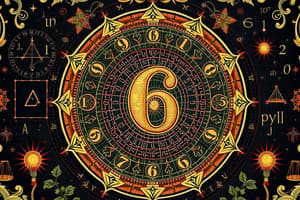Podcast
Questions and Answers
Which of the following sets includes both natural numbers and negative numbers?
Which of the following sets includes both natural numbers and negative numbers?
- Rational Numbers (Q)
- Integers (Z) (correct)
- Whole Numbers (W)
- Natural Numbers (N)
All rational numbers can be expressed as a fraction.
All rational numbers can be expressed as a fraction.
True (A)
What is the formula for calculating the area of a rectangle?
What is the formula for calculating the area of a rectangle?
A = lw
The sum of the angles in a triangle is ___ degrees.
The sum of the angles in a triangle is ___ degrees.
Match the following mathematical concepts with their definitions:
Match the following mathematical concepts with their definitions:
Which of the following represents a complex number?
Which of the following represents a complex number?
The Pythagorean Theorem can be applied to any triangle.
The Pythagorean Theorem can be applied to any triangle.
What is the relationship defined by functions?
What is the relationship defined by functions?
Flashcards are hidden until you start studying
Study Notes
Key Concepts in Mathematics
1. Number Systems
- Natural Numbers (N): Counting numbers (1, 2, 3, ...)
- Whole Numbers (W): Natural numbers plus zero (0, 1, 2, ...)
- Integers (Z): Whole numbers and their negatives (..., -3, -2, -1, 0, 1, 2, 3, ...)
- Rational Numbers (Q): Numbers that can be expressed as a fraction (a/b, where a and b are integers, b ≠ 0)
- Irrational Numbers: Numbers that cannot be expressed as a fraction (e.g., √2, π)
- Real Numbers (R): All rational and irrational numbers
- Complex Numbers (C): Numbers of the form a + bi (where i is the imaginary unit)
2. Basic Operations
- Addition (+): Combining quantities.
- Subtraction (−): Finding the difference between quantities.
- Multiplication (×): Repeated addition of a number.
- Division (÷): Splitting a quantity into equal parts.
3. Algebra
- Variables: Symbols (e.g., x, y) representing unknown values.
- Expressions: Combinations of numbers, variables, and operations (e.g., 2x + 3).
- Equations: Mathematical statements that two expressions are equal (e.g., 2x + 3 = 7).
- Functions: Relationships between inputs and outputs (e.g., f(x) = 2x + 1).
4. Geometry
- Shapes and Properties: Points, lines, planes, angles, polygons, circles, etc.
- Area: The amount of space inside a shape (e.g., A = lw for rectangles).
- Perimeter: The distance around a shape.
- Volume: The space occupied by a 3D object (e.g., V = lwh for rectangular prisms).
5. Trigonometry
- Sine (sin), Cosine (cos), Tangent (tan): Ratios in right triangles.
- Pythagorean Theorem: a² + b² = c² for right triangles.
- Unit Circle: A circle with a radius of 1 used to define trigonometric functions.
6. Calculus
- Limits: The value a function approaches as the input approaches a point.
- Derivatives: Measure of how a function changes as its input changes (slope of a function).
- Integrals: Represents accumulation of quantities and area under curves.
7. Statistics and Probability
- Mean: Average of a data set.
- Median: Middle value of a data set.
- Mode: Most frequently occurring value in a data set.
- Probability: Measure of the likelihood of an event occurring (0 to 1).
8. Discrete Mathematics
- Sets: Collections of distinct objects.
- Graphs: Structures used to model pairwise relationships between objects.
- Combinatorics: Study of counting, arrangement, and combination of objects.
Important Mathematical Symbols
- ∑: Summation
- ∏: Product
- ∞: Infinity
- √: Square root
- |x|: Absolute value
Mathematical Techniques
- Factoring: Breaking down numbers or expressions into their constituent parts.
- Expanding: Distributing terms in algebraic expressions.
- Graphing: Visual representation of equations or inequalities on a coordinate system.
Mathematical Problem-Solving
- Identify the problem: Understand what is being asked.
- Devise a plan: Choose appropriate strategies or formulas.
- Carry out the plan: Implement the chosen methods.
- Review/extend: Check the solution for accuracy and applicability.
Number Systems
- Natural Numbers consist of positive integers starting from 1.
- Whole Numbers include natural numbers and zero, starting from 0.
- Integers encompass all whole numbers and their negative counterparts.
- Rational Numbers can be expressed as the quotient of two integers, with a non-zero denominator.
- Irrational Numbers cannot be represented as fractions; common examples include √2 and π.
- Real Numbers include both rational and irrational numbers, covering all points on the number line.
- Complex Numbers comprise real and imaginary parts, represented as a + bi.
Basic Operations
- Addition combines two quantities to get a total.
- Subtraction calculates the difference between two quantities.
- Multiplication is repeated addition of a number, indicating scaling.
- Division distributes a quantity into specified equal parts.
Algebra
- Variables symbolize unknown amounts and are often represented by letters (e.g., x, y).
- Expressions are combinations of numbers, variables, and operations (e.g., 2x + 3).
- Equations assert that two expressions are equal (e.g., 2x + 3 = 7).
- Functions express a relation between input and output, commonly noted as f(x) = expression.
Geometry
- Geometry involves the study of shapes, properties, and relationships such as points, lines, and angles.
- Area quantifies the space within a two-dimensional shape using formulas (e.g., A = lw for rectangles).
- Perimeter measures the total distance around a shape.
- Volume assesses the space occupied by three-dimensional objects (e.g., V = lwh for rectangular prisms).
Trigonometry
- Key ratios in right triangles include sine (sin), cosine (cos), and tangent (tan).
- The Pythagorean Theorem states a² + b² = c², establishing a relationship between the sides of right triangles.
- The Unit Circle, with a radius of 1, is essential for defining trigonometric functions.
Calculus
- Limits describe the value a function approaches as the input approaches a specific point.
- Derivatives signify the rate of change of a function, analogous to the slope of a graph.
- Integrals represent the accumulation of quantities, often associated with the area under a curve.
Statistics and Probability
- Mean represents the average value within a data set.
- Median is the central value when data is ordered.
- Mode is the value that appears most frequently in a data set.
- Probability quantifies the likelihood of a given event, ranging from 0 (impossible) to 1 (certain).
Discrete Mathematics
- Sets are collections of distinct elements.
- Graphs model relationships through vertices and edges.
- Combinatorics focuses on counting arrangements and combinations of sets.
Important Mathematical Symbols
- ∑ symbolizes summation.
- ∏ denotes product.
- ∞ indicates infinity.
- √ represents square root.
- |x| denotes absolute value.
Mathematical Techniques
- Factoring involves breaking down expressions into simpler elements.
- Expanding spreads out terms in algebraic expressions through distribution.
- Graphing visually represents equations or inequalities in a coordinate system.
Mathematical Problem-Solving
- Identifying the problem lays the groundwork for understanding the query.
- Devise a plan to select the most effective strategies or formulas.
- Carrying out the plan means implementing chosen methods step by step.
- Reviewing and extending verify the solution's accuracy and broaden its applicability.
Studying That Suits You
Use AI to generate personalized quizzes and flashcards to suit your learning preferences.




